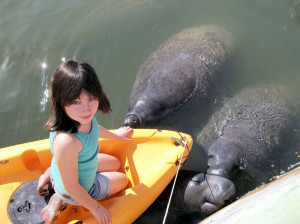
Everyone in the Florida Keys seems to have a story about an encounter with our fascinating sea life. Our visitors especially love to tell about seeing an endangered Florida manatee. While Florida’s manatees have been known to travel as far north as New Jersey and Massachusetts, they, like all good Floridians, return to warmer waters in the winter months. Despite their large size, manatees do not have a layer of protective fat like whales and seals. When water temperature drops below 68 degrees F, manatees can suffer from cold stress. That’s why we see more manatees in the warmer waters of South Florida in the winter months. Manatees must eat nearly 10 percent of their body weight in vegetation every day. For an average adult manatee weighing around 2,000 pounds, that’s a lot of seagrass. If iceberg lettuce was part of the manatee diet, they would have to eat about 200 heads of lettuce daily.
Manatees stay with their mother the first two to three years learning what to eat, where to find food and where to seek shelter from cold temperatures. Adult manatees are typically solitary, only gathering in large groups when they move to warm water refuges. Winter aerial surveys, “synoptic surveys,” are made of all known cold weather gatherings of manatees to determine population levels. The 2015 synoptic survey counted 6,063 manatees in Florida. Researchers often want to identify individual manatees, which is possible by the scar patterns on their bodies. Scars caused by propellers are sharp-edged, while cold stress scars are white spots or blotches, the manatee equivalent of frostbite. Despite these injuries, manatees can live a very long time.
The oldest known manatee, Snooty, who lives at the South Florida Museum in Bradenton, turned 67 this year. The oldest known wild manatees, Merlin and Brutus, are at least 45 years old. They were filmed by Jacques Cousteau for his TV special, “Cousteau’s Mermaids,” in 1972. One of Florida’s most well-known manatees was Georgia. Rescued as an orphan in 1991, she was released a few years later into the St. Johns River. Georgia was attracted to people, often nudging canoes or kayaks she encountered. She gave birth to six calves and adopted several orphaned calves. They all learned from Georgia to like people. In 2014, Florida Park Service staff noted a decline in Georgia’s health. She was rescued and received extensive care, but her condition continued to deteriorate and she died this past April. You can read stories about Georgia at SavetheManateeClub.org.
If you see a manatee in South Florida waters, please only observe from a distance. A friendly manatee (one of Georgia’s offspring?) may approach you. Enjoy the moment, but don’t follow, touch or feed this endangered animal, as it is protected. If the manatee seems to be in distress, call Florida Fish and Wildlife Conservation Commission at 888-404- 3922. For more information about manatees, visit FloridaStateParks.org or any Florida State Park. Share the water and enjoy the Real Florida.
Cass Meadows is assistant park manager of John Pennekamp Coral Reef State Park.
